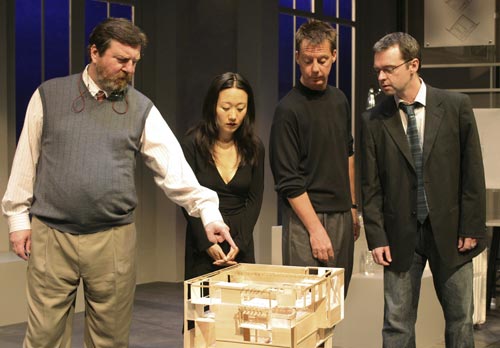|
The recent run of Oren Safdie’s “Private Jokes, Public Places” is yet another futile, theatrical exercise in which skilled actors have done their damndest to rise above mediocre material. The skeletal, two-dimensional plot revolves around “Margaret”, a young, Asian-Canadian female architecture graduate student (played bloodlessly by M.J. Kang) who is in the process of defending her graduate thesis in front of two pompous professors and her class instructor. The fourth wall dimension is broken with the audience members acting as the “class”. We later discover that Margaret is the granddaughter of a noted Asian architect, and that she is hopelessly conflicted by the need to be recognized as an artist, and also the all-consuming need that she has for male approval and acceptance.
Margaret’s project, represented by a miniature balsa-wood scale model, is a sort of industrial, everyman’s public pool, constructed in the shape of a giant cube, with street-level windows designed to eliminate elitism…and the privacy that generally goes along with it. Margaret herself, is an unconventional freethinking architect-in-training, and she (as well as her project) are subjected to a barrage of free-flowing criticism, sexual objectification and mindless pontification from the all-male authority figures.
|
|
The instructor, William (played convincingly by David Jansen) has yet to enter the practical workforce; Colin, (played with great conviction and skill by Victor Ertmanist) is a tweedy, pseudo-British, up-tight, traditional and judgmental department head, who seems to have failed at a professional career, and has subsequently retreated into the sheltered world of academia. The obligatory Euro-trash professor, “Erhardt” is brought to life by the brilliant Dan Lett. Lett was able to spout forth (in a barely-there German accent) the most incredible streams of architectural psychobabble that one could imagine. I was mesmerized as he struck an incredible balance of pontificating madly while at the same time leering at the unfortunate Margaret. I was reminded of a scene from Woody Allen’s “Hannah and Her Sisters”, where Diane Weist listens to a stream of architectural B.S. and says “Where does she come up with that stuff – Oh, I get it, she went to Brandeis”….thereby re-enforcing the old adage, “those who can, do..those who can’t, teach”. Just so much mental masturbation. By the way, the wonderful Dan Lett bears an uncanny resemblance to the late, great comic actor, David Wayne (think Katherine Hepburn and Spencer Tracey’s comic foil of a neighbour in “Adam’s Rib”, or Marilyn Monroe’s bespectacled love interest in “How to Marry a Millionaire”).
One of the most unbelievable aspects of this play was, oddly enough, a wardrobe issue--i.e. the wrap-around “Little Black Dress”, worn by Margaret for the duration of the show (with the exception of the final absurd scene, where the pathetic Margaret rips off her dress in one swift motion, in order to make some sort of negligible point while standing there in her birthday suit). The dress was provocative, and clung to Ms. Kang’s body with little more than double-sided tape. From the moment that Margaret entered the stage – which happens immediately – I was struck by the fact that the scanty dress in question would never have been worn at the occasion of a thesis presentation by any woman who didn’t expect to be judged on her physical assets, as opposed to intellectual ones. In addition, I felt that Ms. Kang’s lack of comfort in the dress was something so palpable throughout, that it made me want to run onstage and put a coat on her, and of course, ultimately this distracted from the evolution of the plot – such as it was.
Although the characters are written as two-dimensional stereotypes, Dan Lett, Victor Ertmanis and David Jansen somehow managed to imbue their characters with interior lives and believable mannerisms and behaviours. Jansen achieves just the right balance of ass-kissing, manipulation and youthful naiveté that one would find in a graduate student, perhaps in his first teaching assignment. As naïve as the character is, he has still managed to plug into the eternal objectification of women, and hit upon his female student, Margaret. It is implied that he has been a mentor to the young woman, and has therefore abused her trust, sacrificed her innocence—and worse.
Ms. Kang is much less fortunate than her male cast members in her portrayal of Margaret. Margaret is presumably written as the protagonist of the piece, and should have been the building block on which the action of the play builds, climaxes and resolves. It was essential for us to like Margaret, for her to elicit our sympathy, and conversely, for us to actively resent the antagonistic, boorish and sexist male characters. Sadly, Margaret remained firmly unlikable, and the fact that she had schtupped her instructor didn’t help matters, but instead short-circuited her credibility as an emerging architect with a marvelous new design for a public building.
At the so-called “climax” of the play, a rainstorm pours down in a thinly veiled illusion equating the drop in barometric pressure with the apex of dramatic action. As I left the theatre, I felt decidedly unsatisfied, and all that I heard the audience murmuring about was what a “wonderful effect” the rain had been. I agree that perhaps the gorgeous set design by Judith Bowden, lighting by Andrea Lundy, and of course “the rain effect” were the highlights of this onerous play. Probably not what the author and director Alisa Palmer were going for.
|


